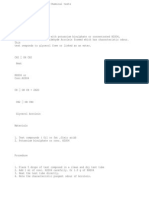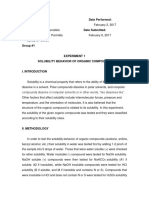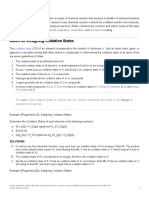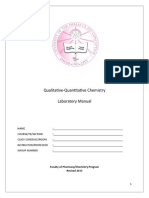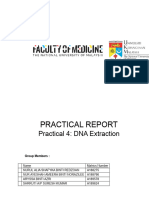Isolation & Characterization of Dna: Objectives
Isolation & Characterization of Dna: Objectives
Uploaded by
Krizzi Dizon GarciaCopyright:
Available Formats
Isolation & Characterization of Dna: Objectives
Isolation & Characterization of Dna: Objectives
Uploaded by
Krizzi Dizon GarciaOriginal Title
Copyright
Available Formats
Share this document
Did you find this document useful?
Is this content inappropriate?
Copyright:
Available Formats
Isolation & Characterization of Dna: Objectives
Isolation & Characterization of Dna: Objectives
Uploaded by
Krizzi Dizon GarciaCopyright:
Available Formats
KEY STEPS:
Isolation & - Homogenization (unifying the components
characterization of your solution; one phase) / Cell lysis
- Deproteinization
of dna - Precipitation (separation of DNA from
solution)
objectives
• Homogenizing solution:
1. Distinguish different components of DNA - Sodium dodecyl sulfate: detergent used to
based on qualitative tests lyse cell wall, cell membrane, & nuclear
2. Evaluate the quality and concentration of membrane
DNA based on absorbance readings - NaCl: stabilizes the negatively charged
3. Propose a method to isolate DNA from DNA (phosphate group)
biological samples *when clumped together the surface area
of the molecule; hence, precipitation
- Sodium Citrate: buffer (maintain the
A. Isolation of dna from onion negative charge of DNA)
- EDTA: chelates metal cofactors of
DNAses/nucleases (preserve the integrity
- Onions are commonly used because it of the DNA molecule)
contains a lot of DNA
• Blending helps in homogenization (for
uniformity)
• Deproteinization – a protease can be added to
the homogenized solution (to remove proteins;
increases purity of DNA isolate) ex: papain
(hydrolyze nucleases)
• Precipitation – separation of DNA
-95% cold ethanol (DNA is insoluble at 65%
EtOH and above)
*DNA is highly concentrated in the nucleus region *water has a higher dielectric constant
compared to EtOH; when high, the interaction of
*The cell wall and cell membrane must be
the (-) charge of the PO4 & (+) charge of Na
disrupted to access the DNA
atoms will be low
*increase the concentration of EtOH for a
greater interaction between PO4 & Na
*EtOH reacts with water and minimizing the
capability of water to solvate the DNA molecule;
hence, the DNA will only interact with each other
for precipitation
DNA Extraction Kits
- Follows the same principle, but the
protocol might vary depending on the
sample
- DNA purity can be assessed by taking the
ratio of absorbances at 260 and 280 nm
(A260/A280)
B. determination of dna > A260 = nitrogenous bases
A280 = aromatic amino acids
concentration & purity
>
DNA Nomograph
How to use:
1. Plot the absorbances at A260 and A280 at
its respective lines (3rd and 2nd lines in the
- Due to absorbance of the aromatic rings nomograph)
of the nitrogenous bases 2. Connect both points and extend the line
- Strongest at 260 nm towards the outer lines to determine the
A260 ∝ [DNA] protein and nucleic acid concentration
*The aromatic rings nitrogenous bases
have the maximum absorbance at 260 nm
- The concentration of a pure DNA sample
can be estimated by:
Conc (𝜇g/mL) = (A260 reading) x dilution factor x 50 𝜇g/mL
*50 𝜇g/mL is a constant which is the molar
absorptivity of DNA
Positive result Blue-dark blue solution
C. acid hydrolysis of dna
- Hydrogen bonds between complementary
bases were cleaved
*DNA would melt; strands would separate
- Depurination would occur in mild acidic
conditions
*purine nitrogenous base would be cleaved
from the nucleotide/nucleoside
- A nucleotide undergoes complete hydrolysis *Intensity of blue color is directly proportional to
when subjected to acid hydrolysis the concentration of DNA (deoxyribose)
> Inorganic phosphate
> 2-deoxyribose
b. Test for phosphate (Ammonium
> Nitrogenous bases
molybdate test)
-Differentiates nucleotide from nucleoside
Reagent Conc HNO3,
(NH4)2MoO4, (heat)
Principle Complexation
Detects Inorganic phosphate
Positive result Yellow ppt
d. chemical characterization
of dna
DNA HYDROLYSATE + Test reagent/procedure
a. Test for Deoxyribose
(Diphenylamine/Dische Reaction)
Reagent Diphenylamine (acidic)
Principle Condensation
Detects Deoxyribose
c. Test for purines (Murexide test)
Reagent Conc HNO3, KOH, or
NH4OH
Principle Condensation
Detects Purines
Positive result Yellow to reddish ppt
*any purine
d. Test for pyrimidines (Wheeler-Johnson
test)
Reagent Ba(OH)2, bromine
water
Principle Bromination, then
hydroxylation
Detects Pyrimidines (except
thymine)
Positive result Yellow then purple
solution
*followed by rearrangement
You might also like
- Samuelson - Textbook of Veterinary HistologyNo ratings yetSamuelson - Textbook of Veterinary Histology710 pages
- EXPERIMENT NO. 2 Guide (The Silver Group)No ratings yetEXPERIMENT NO. 2 Guide (The Silver Group)6 pages
- Post-Lab Activity No. 12 Test For CarbohydratesNo ratings yetPost-Lab Activity No. 12 Test For Carbohydrates7 pages
- Qualitative Test For Elements in Organic CompoundsNo ratings yetQualitative Test For Elements in Organic Compounds4 pages
- Solubility Behavior of Organic CompoundsNo ratings yetSolubility Behavior of Organic Compounds5 pages
- Chem 132.2 - Biochemistry (Laboratory) Laboratory ReportNo ratings yetChem 132.2 - Biochemistry (Laboratory) Laboratory Report4 pages
- Column and Thin Layer Chromatography: Malunggay (Moringa Oleifera)No ratings yetColumn and Thin Layer Chromatography: Malunggay (Moringa Oleifera)3 pages
- Classification Tests For Hydrocarbons Formal Report PDF FreeNo ratings yetClassification Tests For Hydrocarbons Formal Report PDF Free5 pages
- Lab 1 Separation of The Components in A MixtureNo ratings yetLab 1 Separation of The Components in A Mixture3 pages
- Worksheet No. 3 Volumetric Measurements 1 IncompNo ratings yetWorksheet No. 3 Volumetric Measurements 1 Incomp11 pages
- Experiment 1 - Laboratory Activity Sheet For Physical and Chemical Properties of LipidsNo ratings yetExperiment 1 - Laboratory Activity Sheet For Physical and Chemical Properties of Lipids6 pages
- Laboratory Experiment 3 Test For CarbohydratesNo ratings yetLaboratory Experiment 3 Test For Carbohydrates7 pages
- Experiment 7: Stereochemistry and PolarimetryNo ratings yetExperiment 7: Stereochemistry and Polarimetry3 pages
- Group 2 - Post Lab Activity 9 (Pcog Finals)No ratings yetGroup 2 - Post Lab Activity 9 (Pcog Finals)10 pages
- General and Specific Test For Carbohydrates BioChemNo ratings yetGeneral and Specific Test For Carbohydrates BioChem15 pages
- Microscope: Micrometry and The Microbial World100% (1)Microscope: Micrometry and The Microbial World3 pages
- Experiment #1:: Purification of Benzoic Acid by RecrystallizationNo ratings yetExperiment #1:: Purification of Benzoic Acid by Recrystallization51 pages
- Sublimation and Melting Point DeterminationNo ratings yetSublimation and Melting Point Determination3 pages
- Chemical Professionals Code of Conduct 2012No ratings yetChemical Professionals Code of Conduct 20122 pages
- Chapter 9-10 Practice Test: Identify The Choice That Best Completes The Statement or Answers The QuestionNo ratings yetChapter 9-10 Practice Test: Identify The Choice That Best Completes The Statement or Answers The Question16 pages
- 0709 Po102-0012007000007 Powerq Goods TradingNo ratings yet0709 Po102-0012007000007 Powerq Goods Trading2 pages
- MULTIPLE CHOICE. Choose The Best Answer That Completes The StatementNo ratings yetMULTIPLE CHOICE. Choose The Best Answer That Completes The Statement2 pages
- Rizal's Family & Childhood: Lee Mark BanaagNo ratings yetRizal's Family & Childhood: Lee Mark Banaag14 pages
- Polar Lipids - Glycerophoshpolipids, Sphingolipids Neutral Lipids - CholesterolNo ratings yetPolar Lipids - Glycerophoshpolipids, Sphingolipids Neutral Lipids - Cholesterol5 pages
- List of Instruments and Equipments Pharmacognosy Laboratory S.N o Essential Equipment and Instruments Count/Availability of Instruments/Equipments0% (1)List of Instruments and Equipments Pharmacognosy Laboratory S.N o Essential Equipment and Instruments Count/Availability of Instruments/Equipments2 pages
- TFS Assets LSG Certificate Certificates of Analysis 27 1021 82 YC1712No ratings yetTFS Assets LSG Certificate Certificates of Analysis 27 1021 82 YC17122 pages
- Material Safety Data Sheet: According To 1907/2006/EC, Article 31No ratings yetMaterial Safety Data Sheet: According To 1907/2006/EC, Article 314 pages
- CP 1 - Finding The Molar Volume of A GasNo ratings yetCP 1 - Finding The Molar Volume of A Gas3 pages
- Ozonolysis of Fatty Acids and Their Derivatives: 20 ProgressNo ratings yetOzonolysis of Fatty Acids and Their Derivatives: 20 Progress22 pages
- Indones. J. Chem., 2022, 22 (1), 171 - 178: AbstractNo ratings yetIndones. J. Chem., 2022, 22 (1), 171 - 178: Abstract8 pages
- Chapter 1 Introduction To Anaytical ChemistryNo ratings yetChapter 1 Introduction To Anaytical Chemistry13 pages
- Qualitative Test For Elements in Organic CompoundsQualitative Test For Elements in Organic Compounds
- Chem 132.2 - Biochemistry (Laboratory) Laboratory ReportChem 132.2 - Biochemistry (Laboratory) Laboratory Report
- Column and Thin Layer Chromatography: Malunggay (Moringa Oleifera)Column and Thin Layer Chromatography: Malunggay (Moringa Oleifera)
- Classification Tests For Hydrocarbons Formal Report PDF FreeClassification Tests For Hydrocarbons Formal Report PDF Free
- Experiment 1 - Laboratory Activity Sheet For Physical and Chemical Properties of LipidsExperiment 1 - Laboratory Activity Sheet For Physical and Chemical Properties of Lipids
- General and Specific Test For Carbohydrates BioChemGeneral and Specific Test For Carbohydrates BioChem
- Experiment #1:: Purification of Benzoic Acid by RecrystallizationExperiment #1:: Purification of Benzoic Acid by Recrystallization
- Chapter 9-10 Practice Test: Identify The Choice That Best Completes The Statement or Answers The QuestionChapter 9-10 Practice Test: Identify The Choice That Best Completes The Statement or Answers The Question
- MULTIPLE CHOICE. Choose The Best Answer That Completes The StatementMULTIPLE CHOICE. Choose The Best Answer That Completes The Statement
- Polar Lipids - Glycerophoshpolipids, Sphingolipids Neutral Lipids - CholesterolPolar Lipids - Glycerophoshpolipids, Sphingolipids Neutral Lipids - Cholesterol
- List of Instruments and Equipments Pharmacognosy Laboratory S.N o Essential Equipment and Instruments Count/Availability of Instruments/EquipmentsList of Instruments and Equipments Pharmacognosy Laboratory S.N o Essential Equipment and Instruments Count/Availability of Instruments/Equipments
- TFS Assets LSG Certificate Certificates of Analysis 27 1021 82 YC1712TFS Assets LSG Certificate Certificates of Analysis 27 1021 82 YC1712
- Material Safety Data Sheet: According To 1907/2006/EC, Article 31Material Safety Data Sheet: According To 1907/2006/EC, Article 31
- Ozonolysis of Fatty Acids and Their Derivatives: 20 ProgressOzonolysis of Fatty Acids and Their Derivatives: 20 Progress
- Indones. J. Chem., 2022, 22 (1), 171 - 178: AbstractIndones. J. Chem., 2022, 22 (1), 171 - 178: Abstract














